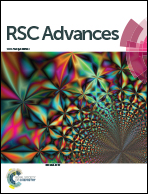Cross-linked nanofilms for tunable permeability control in a composite microdomain system†
Abstract
Fabrication of microcapsule based composite materials with precise control over diffusion is desirable for applications in anti-corrosive agent release, drug delivery, and biosensing. Self-assembled layer-by-layer (LbL) nanofilms may be used to control analyte flux in these advanced materials because they allow accurate manipulation of interface properties on the nanoscale. The transport of a model analyte was evaluated across glutaraldehyde cross-linked PAH [poly(allylamine hydrochloride)]/PSS [poly(sodium 4-styrenesulfonate)] nanofilm constructs to determine the potential of these bilayers to precisely control small-molecule diffusion. Measurements of glucose permeation rates across nanofilms deposited on planar porous substrates revealed that glutaraldehyde-mediated cross-linking drastically decreased transport across PAH-containing bilayers. Additionally, we found that analyte permeation rates can be finely tuned by controlling the degree of intralayer and interlayer PAH cross-linking. To realize the practical application of these nanofilms in micro-scale flux-based devices, the planar multilayer scheme was used to line glucose-sensing microdomains entrapped in alginate matrices. These glucose sensing nanocomposite hydrogels exhibited sensitivity and analytical range that are adjustable depending upon the characteristics of the multilayers; cross-linking of the nanofilm lining the microdomains to limit glucose diffusion resulted in an extension of the analytical range by ≈249% and a decrease in the corresponding sensitivity by ≈85%. This demonstration of control over small-molecule diffusion in microdomain-populated hydrogel materials opens the possibility to use these devices for multifunctional purposes, including biosensing and controlled release of encapsulated species such as drugs, coloring/flavoring agents, anti-corrosives, and other active molecules.


 Please wait while we load your content...
Please wait while we load your content...